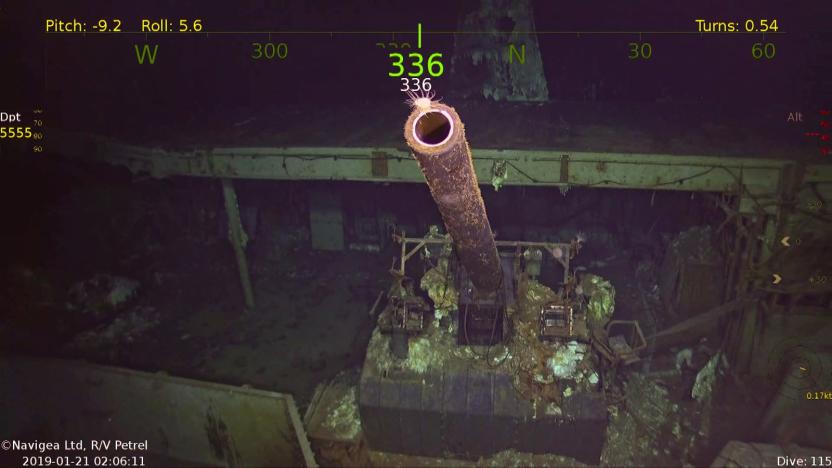AutonomousUnderwaterVehicle
Latest

Sonar drone discovers long-lost WWII aircraft carrier USS Hornet
The late Paul Allen's research vessel, the Petrel, has found another historic warship at the bottom of the ocean. In the wake of an initial discovery in late January, the expedition crew has confirmed that it found the USS Hornet, an aircraft carrier that played a pivotal role in WWII through moments like the Doolittle Raid on Japan and the pivotal Battle of Midway. It was considered lost when it sank at the Battle of Santa Cruz in October 1943, but modern technology spotted it nearly 17,500 feet below the surface of the South Pacific Ocean, near the Solomon Islands.

Microsoft co-founder's remote vehicles find a legendary WWII ship
The USS Indianapolis played an important role in WWII history, including the delivery of parts for the atomic bombs that would eventually drop on Japan. However, it met a grim fate: not only did a Japanese submarine sink it near the end of the war, but its wreck has remained elusive despite multiple expeditions over the past 72 years. Technology just provided some resolution, though. A team piloting Microsoft co-founder Paul Allen's research vessel, the R/V Petrel, has found the wreck of the Indianapolis at the bottom of the Philippine Sea. The discovery was helped by a mix of better information and the equipment aboard the Petrel itself.

University of Victoria's Mano underwater robot to prowl Arctic waters for legendary ships
Canadians well-versed in their history are very aware of Sir John Franklin's ill-fated 1845 expedition to find the Northwest Passage: a British voyage that set out to establish a sailing route through the Arctic and ended with the untimely, mysterious deaths of its two ship crews. No human ever found the abandoned ships, which makes it all the more fitting that the next best shot at discovery might come through a just-launched autonomous underwater vehicle from the University of Victoria and Bluefin Robotics. Meet the Mano, a new sonar-toting robot that can produce detailed undersea maps all by its lonesome while keeping a steady altitude above the ocean floor. It can only operate for 12 hours at a time, which will keep humans in the area, but its ability to run untethered below storms and cold Arctic winds should dramatically expand the territory that researchers can cover during their share of a larger five- to six-week journey. There's no guarantee that the Mano will hit the jackpot, or find something recognizable even if it does. Still, any mapping should improve navigation for modern boats -- and hopefully prevent others from sharing Sir Franklin's fate.

SubjuGator repeats at 9th annual AUV competition
Those peeps from the University of Florida's still awesomely-named SubjuGator team have dominated the annual Autonomous Underwater Vehicle Competition once again this year, repeating their hard-fought victory from last year's event. Like last year, the competition entailed finding a docking station, inspecting a pipeline, and surfacing in a recovery zone, all autonomously, of course. The SubjuGator bot itself, however, went under some major changes for this year's event, with about 70% new parts, although it's still based on a single-board Pentium M system running Windows XP. We'd suggest the other teams start working to increase their game now, cause the odds seem to be shaping up well for a three-peat.[Thanks Sean C]

